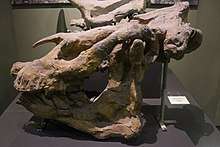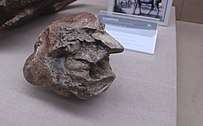Dzungariotherium
Dzungariotherium is a genus of indricothere, an extinct group of large, hornless rhinos, which lived during the middle and late Oligocene of northwest China. The type species D. orgosense was described in 1973 based on fossils—mainly teeth—from Dzungaria in Xinjiang, northwest China.[1]
| Dzungariotherium | |
|---|---|
 | |
| Skull of D. orgosense, Tianjin Natural History Museum | |
| Scientific classification | |
| Kingdom: | Animalia |
| Phylum: | Chordata |
| Class: | Mammalia |
| Order: | Perissodactyla |
| Family: | †Hyracodontidae |
| Subfamily: | †Indricotheriinae |
| Genus: | †Dzungariotherium Chiu, 1973 |
| Type species | |
| †Dzungariotherium orgosense Chiu, 1973 | |
| Species | |
| |
| Synonyms | |
| |
.jpg)
Description
The teeth of D. orgosense (from which that species is mainly known) are 25 percent larger than those of Paraceratherium transouralicum, indicating that it was one of the largest known indricothere,[2] but the teeth and skull was proportionally large compared to the body, making it smaller overall.[3]
Paraceratherium bugtiense and D. orgosense share features such as relatively slender maxillae and premaxillae, shallow skull roofs, mastoid-paroccipital processes that are relatively thin and placed back on the skull, a lambdoid crest, which extends less back, and an occipital condyle with a horizontal orientation. D. orgosense is distinguished from Paraceratherium species by the larger size of its teeth, and distinct crochets of its molars.[4]
References
- Zhan-Xiang, Q. (1973). "A new genus of giant rhinoceros from oligocene of Dzungaria, Sinkang" (PDF). Vertebrata PalAsiatica. 11 (in Chinese and English). 2: 182–191.
- Prothero, 2013. pp. 67–86
- Larramendi, A. (2016). "Shoulder height, body mass and shape of proboscideans" (PDF). Acta Palaeontologica Polonica. 61. doi:10.4202/app.00136.2014.
- Lucas, S. G.; Sobus, J. C. (1989), "The Systematics of Indricotheres", in Prothero, D. R.; Schoch, R. M. (eds.), The Evolution of Perissodactyls, New York, New York & Oxford, England: Oxford University Press, pp. 358–378, ISBN 978-0-19-506039-3, OCLC 19268080
